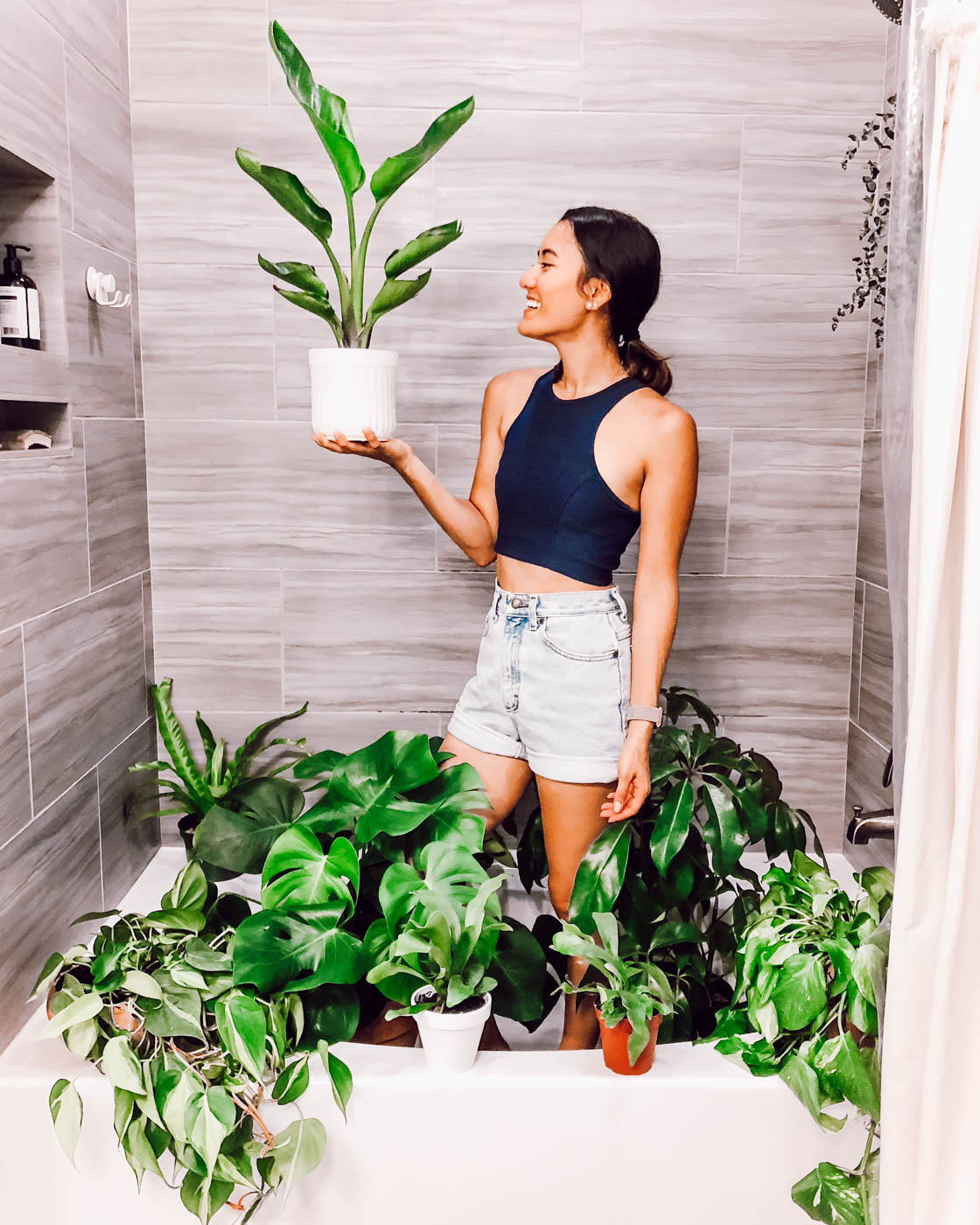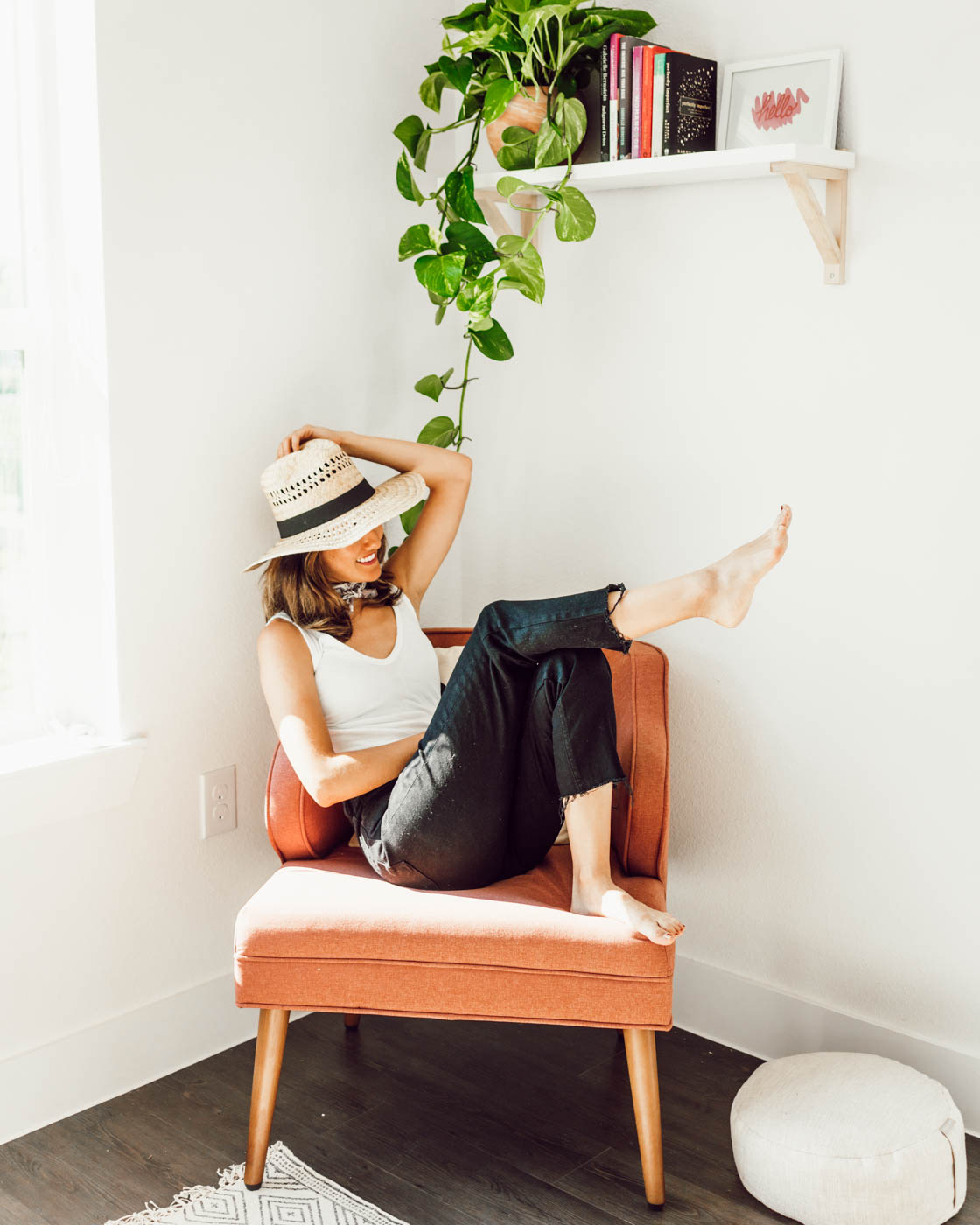A Quick Guide to Houseplants for Beginners
Most of my life I considered myself to have a black thumb. I had zero faith in my plant mama abilities, but looking back, it was because I didn’t really try. I killed one bamboo plant from IKEA, and then it was as if I had ‘plant killer’ marked on my record. It wasn’t until I started living with Andrew two years ago that I decided to give it another try. Fast forward to today, I have over 20 thriving houseplants! Why? A few reasons: Plants are beautiful, they add life to any space (without adding clutter), and they are good for your health.
Yep, just looking at greenery has been known to improve your mood. Research has proven plants reduce stress, promote wellbeing, and enhance productivity. Our innate tendency to want to connect to nature and other life forms is called Biophilia. And ironically the average American spends 90% of their life indoors, which goes against our human nature.
Plants also purify the air in your home by reducing pollutants and toxins and are natural humidifiers, which is especially handy during the winter months when indoor air can become extremely dry.
But when it comes to picking the right plant (or plants) for your indoor space, it’s not one pot fits all. Here are some things you’ll want to consider when you’re choosing your green friends:
Start slow and grow into that green thumb
Get a few small, inexpensive plants from your local nursery or at a grocery store like Whole Foods to test the waters. The cost of plants can add up, so don’t go overboard trying to create your home jungle if you’re not sure how to take care of it. I recommend starting with something super easy like pothos or philodendron! These viney plants are super low maintenance, and grow long beautiful vines rather quickly. They like both low or bright, indirect light and need to be watered once a week or whenever their soil dries out. If you go out of town for a couple weeks and they come back looking droopy, they are easy to revive with just a fresh watering!
Pro Tip: Clip a few vines and place them in a vessel with water. You can scatter these clippings all over the house to add some more life to your space. I have a few clippings in my bathroom, kitchen, and on my bookshelf! You can save old mason jars, glass soap dispensers or wine bottles to use as a recycled vessel.
Find the best location for each plant
Ask yourself what sort of space you are looking to add your plant to. This is usually a good starting point when you’re considering any new green addition.
Is it for a bright, sunny windowsill or will it be sprucing up your desk space and away from most sunlight or where curtains are usually drawn?
Will this plant be sitting in a large open space or is it more likely to be sitting on a shelf or in a corner spot?
Does the temperature in the room change substantially from day to evening or summer to winter?
Now, aim to try and match the space and the lighting to the plant’s ideal conditions. You can find this out by asking someone at a plant shop or just googling the name of the plant you purchased once you get home.
Ideal plants for any lighting
Low Light: Plants with large dark leaves typically need less light to thrive.
This crew loves to hang out in the shade! They prefer low light environments and can survive in rooms with very few windows and limited sunlight.
Ideal low light plants:
Snake Plant
ZZ plant
Pothos / Philodendron
Moderate: Plants with colored or patterned leaves and tropical plants.
These plants thrive in rooms with windows or with some curtains pulled. They do well in a sunny room, but not directly in the sunlight.
Ideal moderate light plants:
Croton
Fern (Staghorn, Boston, Ribbon, etc.)
Schleferra
Bright to direct sunlight: Typically succulents and other thick-leafed plants.
These guys love a window seat. They’ll take lots of bright, natural light and overhead indoor lighting.
Ideal bright and direct light plants:
Succulents / Cacti
Aloe Vera
Fiddle Leaf Fig
Learn to read the soil
The key factor to keeping plants alive is learning how to read the soil. There's a fine balance between underwatering and overwatering, and neither of which is good. A rule of green thumb for most plants is to wait until the first inch of soil dries or becomes cracked and that’s typically a good indicator that your plant is ready for some hydration. Desert plants like cacti and succulents, however, like to stay dry and only need a light misting every few weeks. As for most of my plants, I water them every Sunday, and that seems to be the right cadence for me.
If the soil is either continually too dry or damp, the plant’s roots can be affected which can eventually lead to either limited growth or even death of the plant, so aim for that happy middle ground. It takes time to understand your plant. I share more about gauging the warning signs at the end of this post under FAQ's.
Preventing Bugs
Anytime you buy a plant there’s a chance for some unwelcome pests in the soil. Whenever I bring home a new plant baby, I take precaution (especially if it’s from Home Depot or IKEA) by mixing the soil with Diatomaceous Earth (Food Grade). This is a non-toxic way to kill most bugs, and it's safe for pets and children. Just make sure you don’t inhale when you’re mixing it together. Then, I spray a homemade bug repellant of tea tree (1 Tbsp) with water (1 cup) and spray my plants and soil.
Now, if I see a gnat or two flying around then I pop out these gnat traps, which are a just yellow sticky paper with no chemicals. The bright yellow color naturally attracts and traps them.
You can also add 8-10 drops of lemon essential oils to an 8 oz bottle of water and spray the leaves to prevent future pests. Lemon is a natural deterant and it smells good!
FAQ's
1. What plants do you own/what are your favorite plants and why? I have a snake plant, several pothos and philodendrons, two staghorn ferns, monstera, schefflera or “umbrella” plant, dracaena massangeana or “corn” plant, ribbon fern, peperomioides, and birds of paradise. It’s hard to pick a favorite, but I definitely recommend getting a staghorn fern because they are unique and beautiful, and also get a monstera for a beautiful statement plant that is easy to take care of and grows fast (hence, the ‘monster’ in monstera).
2. What kind of pots do you recommend, and where do you get them? Terra Cotta pots are some of the cheapest pots you can get, and they do the job! You can find them at most plant nurseries. I always recommend getting a pot with a drainage hole or at least drill one in at the shop. This will ensure that any excess water drains out rather than sitting at the bottom causing root rot. Otherwise, you can keep the plant in the plastic drainage pot and put it inside a nice ceramic pot. I have beautiful ceramic planters from a few local shops in Austin, Etsy, and Urban Outfitters has some cute affordable ones!
3. How do you know when a plant is truly dead and won’t come back to life? As a general rule of them, plants will give you a few signs before just straight up die. If the leaves turn yellow, chances are you’re overwatering it. If they start curling in and turn brown, they usually need more water. If a plant dries up, turns crunchy, and you try to water it, but the soil stays wet for several days, then it’s dead, because it’s not drinking up the water. It happens - it’s the circle of life.
Got anymore plant Q's? Leave 'em below and perhaps I'll make a part two!
Check out my plant babies and more tips from me shared on Well+Good and mindbodygreen!






